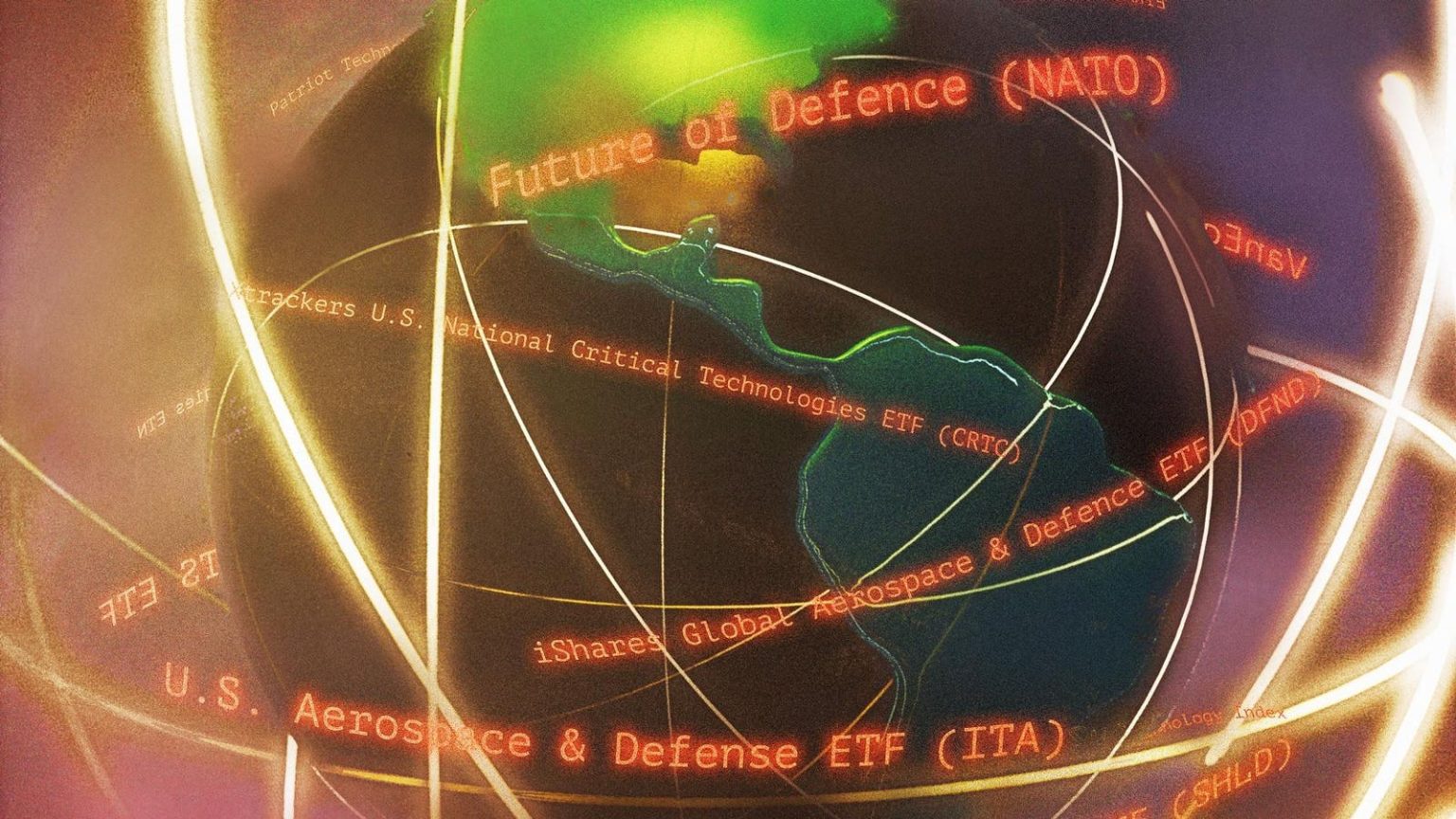As globalization unravels, a Cold War is beginning to take shape, with China replacing the Soviet Union as the main U.S. antagonist. New technologies will become key weapons, requiring new investor strategies.
By Mitchell Martin, Forbes Staff
There is a Chinese folktale about a street entertainer with a dancing monkey. One day, the monkey refused to dance, so the entertainer killed a live chicken right in front of it. After that, the monkey resumed dancing.
When you read about Beijing throwing its weight around in the South China Sea against its smaller neighbors, you can think of China as the entertainer, the Philippines and Vietnam as sacrificial chickens, and Taiwan as the monkey. For many in the United States, these troubles seem distant, but for global investors who watch other people’s money, the growing tensions are top-of-the-mind.
In a January study of global CEOs, the EY professional-services firm formerly known as Ernst & Young found that 98% of respondents said they were taking action because of factors related to geopolitics, which is to say international disputes. A Bank of New York Mellon (BNY) survey of 189 family offices around the world found that 49% of these stewards of wealth listed geopolitics and the related issue of cybersecurity among top areas of concern, with those managing more than $1 billion far more fearful than smaller organizations.
“Geopolitical risk is higher up on our list of considerations than it normally is for investors,” says Dave Bianco, chief investment officer, Americas, for Frankfurt’s DWS Group, a $1 trillion asset manager previously known as Deutsche Asset Management. “Unfortunately, I think this has been the case ever since Russia invaded Ukraine,” he adds. There is also the issue of difficult relations between China and the United States. “It’s gotten more strained [because] we judge each other by the company and friends we keep, and China’s keeping company and friends with what I would describe as bad actors,” specifically, Russia, Iran and Beijing’s “usual partner in crime, North Korea.”
When you add in military actions in Gaza, Israel and the Red Sea, the inflation overhang from the Covid-19 pandemic, climate change, and cyberterrorism, you get a recipe for a world that is fraught with risk. “Maybe we are at a new type of Cold War, says Bianco.
On Wall Street, the knee-jerk reaction has always been to buy major aerospace and defense companies, but that may no longer be the best strategy given the shift toward technology as a key battlefront. “Whilst traditional aerospace and defense can be important industry sectors to consider, the Department of Defense has clearly stated that economic security and national security are entirely intertwined,” says Amanda Rebello of DWS. Shorter supply chains, presaged by the pandemic, can also mean increased national self-reliance, especially for energy.
“Geopolitics is not just about where does the next war break out,” says Sinead Colton Grant, chief investment officer at Bank of New York Mellon’s BNY Wealth unit, “but understanding that you don’t have to get to that point before it will start having an impact on investment opportunities.”
“For the last four or five decades, we’ve been in an operating environment of ever more globalization, defined as the free movement of people, goods, ideas, and capital,” says John O’Connor, CEO of New York’s J.H. Whitney Investment Management. “And now we’re reversing all that. The movement of people, goods, ideas and capital is less free.”
J.H. Whitney has been around since 1946 and is one of the oldest venture-capital firms. Founder John Hay “Jock” Whitney, a member of the prominent Whitney family, was an American ambassador to the U.K. and the last owner of the New York Herald Tribune. One of its current businesses involves using data and analytics to advise governments, including Japan and the U.S., on geopolitical concerns. China’s rising power and deglobalization are the firm’s major themes today.
“All those things that used to work on globalization are rapidly reversing. And so that’s why you end up having trade tariffs, trade barriers where the economy and technology are elements of national power that need to be managed actively as opposed to laissez-faire of the invisible hand,” says O’Connor, “So it’s that transition from monopolar to multipolar. You get decoupling. And at the same time you’re trying to do a global initiative like decarbonization, which gives rise to a really complicated environment to either be a policymaker in government or a profit maker in business or an investor.”
Whitney is supplying DWS with “geostrategic risk ratings” for stocks. DWS has incorporated the concept into a U.S. exchange-traded fund called the Xtrackers U.S. National Critical Technologies ETF (CRTC) and also used it to advise institutions, according to Rebello , who heads sales of the Xtrackers funds in the U.S.
The ratings were created in response to interest from the U.S. Defense Department, which was seeking to add investment products that reflected its goals to a savings plan for government employees. They identify large and mid-cap stocks in developed countries that are included in one of 14 industries the DOD considers critical to national competitiveness. Those issuers are then screened by 10 geographic factors such as where the companies are incorporated and where they do business.
The sectors include a few defense oriented areas, such as hypersonics and energy weapons, but most are categories you might not expect, things like biotechnology, human-machine interfaces and quantum science. The geographic weightings give preference to companies connected with one of the so-called Five Eyes intelligence-sharing countries (Australia, Canada, New Zealand, the U.K. and the U.S.), and the resulting Solactive Whitney U.S. Critical Technologies Index looks a lot like a large-cap U.S. tech fund, led by Nvidia, Alphabet, Microsoft, and Amazon.
Notable by its absence is Apple, hamstrung by its reliance on China for customers and manufacturing, according to the DWS executives. The first traditional defense holding is Honeywell International, the 24th-largest position in the 222-security portfolio, accounting for less than 1%. The ETF was introduced in November and has a 15.1% total return this year, trailing the Standard & Poor’s 500’s 18.1%. The ETF has garnered modest assets of $54.2 million, but the strategy seems to have adherents: UBS preceded the ETF with an exchange-traded note called ETRACS Solactive Whitney U.S. Critical Technologies (WUCT) carrying a 30-year term with put and call options that has reached a value of $68 million since its March 2023 debut. The non-interest-bearing note’s value is linked to the level of the index at maturity or when the notes are repurchased by UBS. It is up 18% this year.
On Monday, American National Insurance announced it was using a variation on the Whitney strategy in its deferred annuity program. Teaming up with BNP Paribas, the insurer is offering customers a chance to link their contracts to the Patriot Technology Index, which melds a 60% position in the Critical Technologies Index with 40% in fixed income to limit volatility.
A slightly different approach to defense-tech comes from The Global X Defense Tech ETF (SHLD) offered by Seoul-based Mirae Asset, which designed its own index. The ETF concentrates on defense-technology and cyberspace but does not stray as far from traditional military contractors as the Whitney index. Aerospace contractors Lockheed Martin and RTX are SHLD’s biggest holdings, each just under 8%, and the ETF is up 23.6% for the year. The $352 million fund debuted on September 11, 2023.
Custom indexes for funds have been growing in popularity for about 10 years, says Rob Isbitts, an ETF specialist who founded the research sites ETFYourself.com and SungardenInvestment.com. They allow for rules-based portfolio management of niche themes in a transparent way that facilitates compliance and trading, while outsourcing the construction and pricing to companies like Whitney frees managers to concentrate on the rest of their business.
Investors in Europe are also becoming interested in defense assets, and three ETFs have sprung up to serve them in a little over a year counterbalancing another recent trend, ESG investing, which typically excludes companies that serve the military.
“Roughly year and a half, two years ago, I started getting a lot of questions from retail investors about why there wasn’t any ETF focusing on the defense industry,” says Martijn Rozemuller, CEO Europe for the New York-based investment advisor VanEck, which manages $100 billion of assets. “And at first my answer would be ‘it’s very hard to do that because all the banks, brokers that we deal with have certain ESG criteria and they will not onboard the product if it’s investing in the defense industry.’”
Eventually Van Eck figured out a way to create a defense focused fund that avoided controversial weapons that banks and brokers shun. Dollar-denominated VanEck Defense (DFNS) is an ETF that owns companies with at least half their sales from “defense-related activities,” says Roel Houwer, senior product manager. Those activities run the gamut from military contracting to unmanned vehicles to cybersecurity, Houwer adds. Excluded from the fund is Northrop Grumman, which flunks a weapons screen because it is involved with nuclear weapons, and RTX because of a human-rights violation involving laser-guided bombs used in Yemen by a Saudi Arabian and United Arab Emirates-led coalition.
Analytic software company Palantir of Denver is the top holding at about 9.2% of the $905.7 million portfolio, followed by Reston, Virginia-based Leidos Holdings, which provides defense, intelligence to the U.S. government. American companies dominate defense and deglobalization portfolios, even in a Europe-based fund meant to appeal to European investors, and they amount to 62% of DFNS. Thales Group, however, a producer of electrical systems for aerospace and the military and based in the Paris suburb of La Defence, is the fourth-largest holding, and helicopter maker Leonardo of Rome is fifth. The dollar-denominated ETF is up 28.6% this year.
BlackRock, which offers the iShares Global Aerospace & Defence ETF (DFND) has taken a different approach, opting for a traditional mix of aerospace and defense contractors based on a Standard & Poor’s index. Its top two holdings are RTX and Boeing, accounting for more than 20% of the $77 million fund’s assets. The portfolio’s 10 biggest positions have six companies in common with BlackRock’s similar American offering, the iShares U.S. Aerospace & Defense ETF (ITA) fund, which tracks the Dow Jones U.S. Select Aerospace & Defense Index. The broader DFND adds European companies Airbus, Safran, Rolls-Royce Holdings and BAE Systems but still allocates two-thirds of its portfolio to U.S. stocks. Along with the more diverse geographic footprint—practically all of $6.2 billion of ITA’s equities are American—DFND spreads its risk over 55 issues vs. 35 for the American version.
DFND made its debut in February, and is up 12.3% since then. That’s better than the 10.2% of its less diversified U.S. counterpart ITA, which is hurt by its larger exposure to Boeing, but still behind the S&P 500’s 12.3% over that span.
The third new European ETF, Future of Defence (NATO) lives up to its ticker by focusing on spending by European members of the North Atlantic Treaty Organization as they bolster defense outlays. It has a 59% allocation to U.S companies., followed by 9.9% to France and 7.2% each to Israel and the U.K. The cybersecurity company Check Point Software, based in Tel Aviv, is the top position, followed by Leonardo and Safran. The $420.2 million portfolio is up 20.3% this year.
The European ETFs are structured as UCITs (Undertakings for the Collective Investment in Transferable Securities) and are tricky for American citizens to buy, with availability depending on where you have your brokerage account.
While deglobalization is already occurring, it is unclear how much of an overhaul is yet needed in business practices.
“We believe it’s really important to be really careful with the analysis and not simply to say the whole world is getting more complicated, “ says Oliver Jones. head of EY’s geostrategic business group. “The industry question is how specifically for you and your operating model and your strategy is the world becoming more complicated, and do you need to react?”
EY has mapped out four scenarios for 2027 that it considers plausible:
• Globalization Lite
• Friends First
• Cold War II
• Self-Reliance Reigns
The middle two are the most likely, according to Courtney Rickert McCaffrey, insights leader for Oliver’s group and co-author with him of the book, Geostrategy by Design. Globalization Light is a modest rollback of integration, “sort of a partial return to the early 2000s,” she says, while Self-Reliance Reigns is a worst-case scenario for global investors under which “countries turn inward” and focus on their own economies, without much consideration for anyone else, even their allies.
That leaves the more likely outlooks of Friends First, in which companies choose to do most of their business in friendly nations, she says, and Cold War II, a replay of the first one but with China taking the place of the U.S.S.R. “Those two do seem the most likely at this point. And indeed there’s some aspects of them that are already coming into play in the current environment,” says Rickert McCaffrey.
In EY’s CEO survey that found 98% of companies are already making changes to adjust to deglobalization, 40% said they were altering their supply chains, according to Jones, 38% are canceling investments and 37% are relocating assets.
Says Jones, “They’re making fundamental changes.”
MORE FROM FORBES
Read the full article here
















